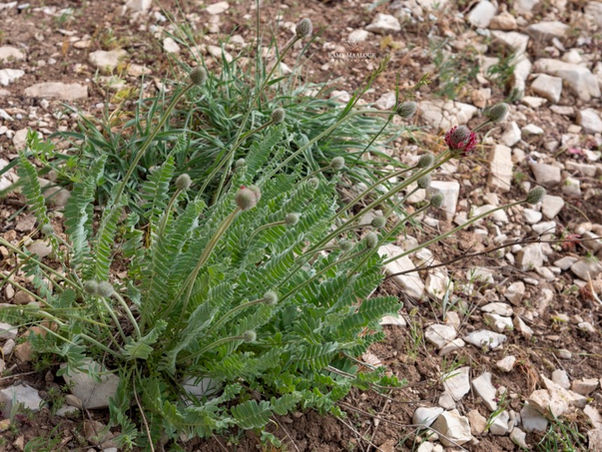Family |
Fabaceae
Astragalus emarginatus
Labill.
Leb. Syr. Tur.
Astragalus emarginatus Labill.
(Nouvelle Flore du Liban et de la Syrie, vol. 2, Pl. CXXVII nº 1; 1983)
Life-form & habit: Briefly caulescent perennial, 5–15 cm tall, covered in greyish to yellowish tomentum.
Leaves: Up to 20 cm long, with 18–25 pairs of linear-oblong, retuse, pale grey to grey-yellowish leaflets. Stipules fused into a single, long-triangular-lanceolate, bi-acuminate sheath.
Inflorescence & flowers: Thick, scapiform peduncles, reaching 40–50 cm or more including the flower. Inflorescence ovate to ovate-oblong, dense, 2–5 cm long. Bracts narrowly lanceolate, very hispid, half the length of the calyx.
Calyx: Densely hispid with subulate teeth slightly shorter than or nearly equaling the tube.
Corolla: Purple, only slightly exceeding the calyx; standard longer than wings and keel.
Fruit: Short, very shortly mucronate pods, nearly hidden by a very long hairy indumentum.
Phenology: Flowers from June to August.
Habitat & elevation: Mountain zones.
Lebanese distribution: Mi-Mm. Ma‘asser ech-Chouf, above Jeba‘a; Mm. Cedars of Barouk, Jabal Barouk, Kfar Selouane to ‘Aïn Saoua‘ir, Jabal Kneissé, ‘Aqoura, Hasroun Valley, Tannourine, Cedars, Ehden; Ve. Mchaïtiyé to Aïnata; Herm. above Hasbaya; A.L. Fakiyé; S. A.L. Tala‘at Moussa
Native range: Endemic to Lebanon and parts of western Syria





